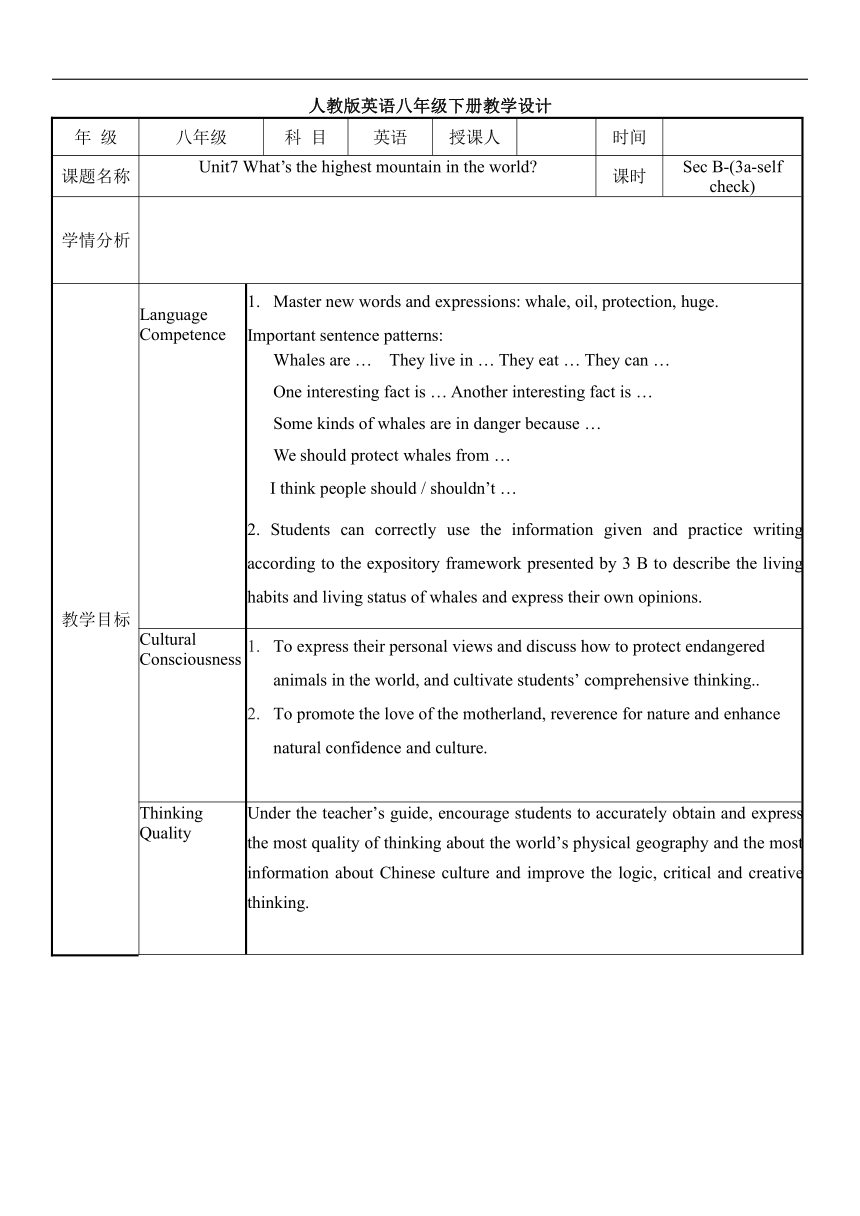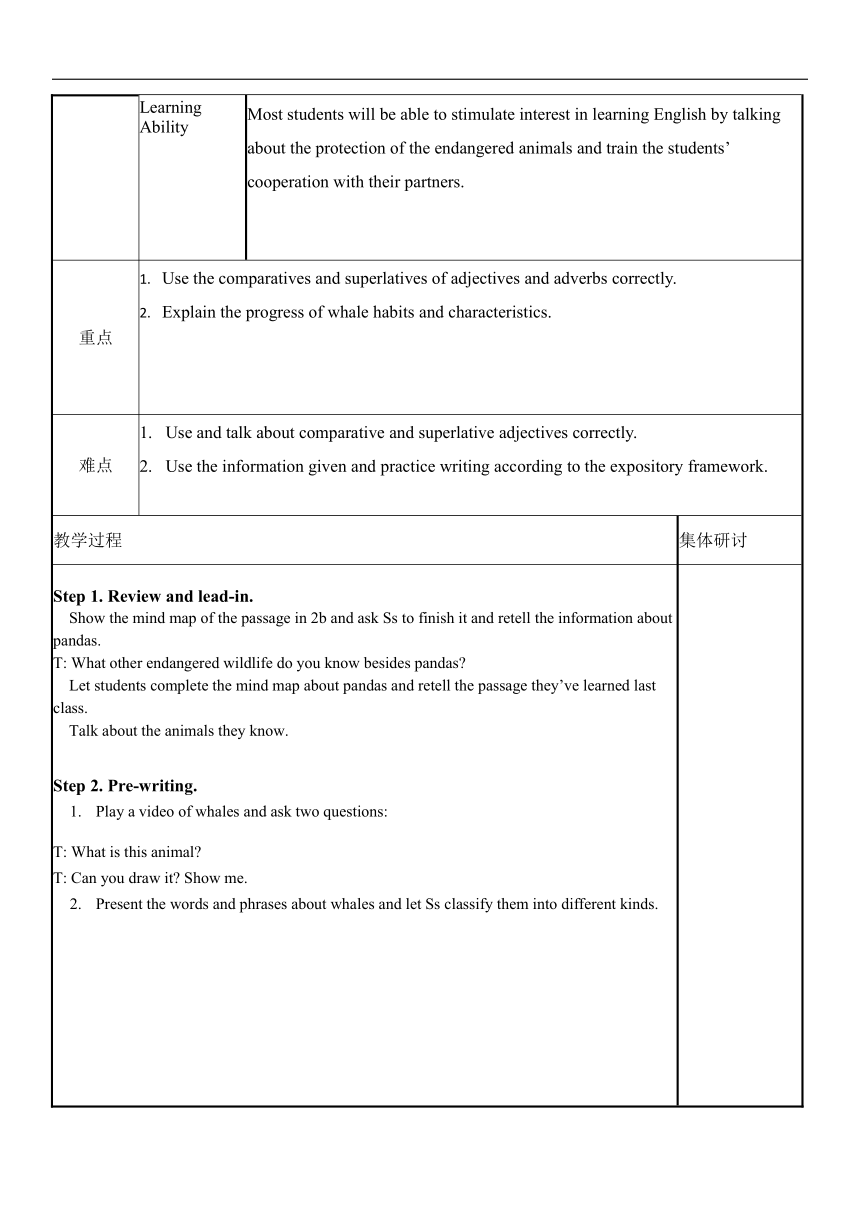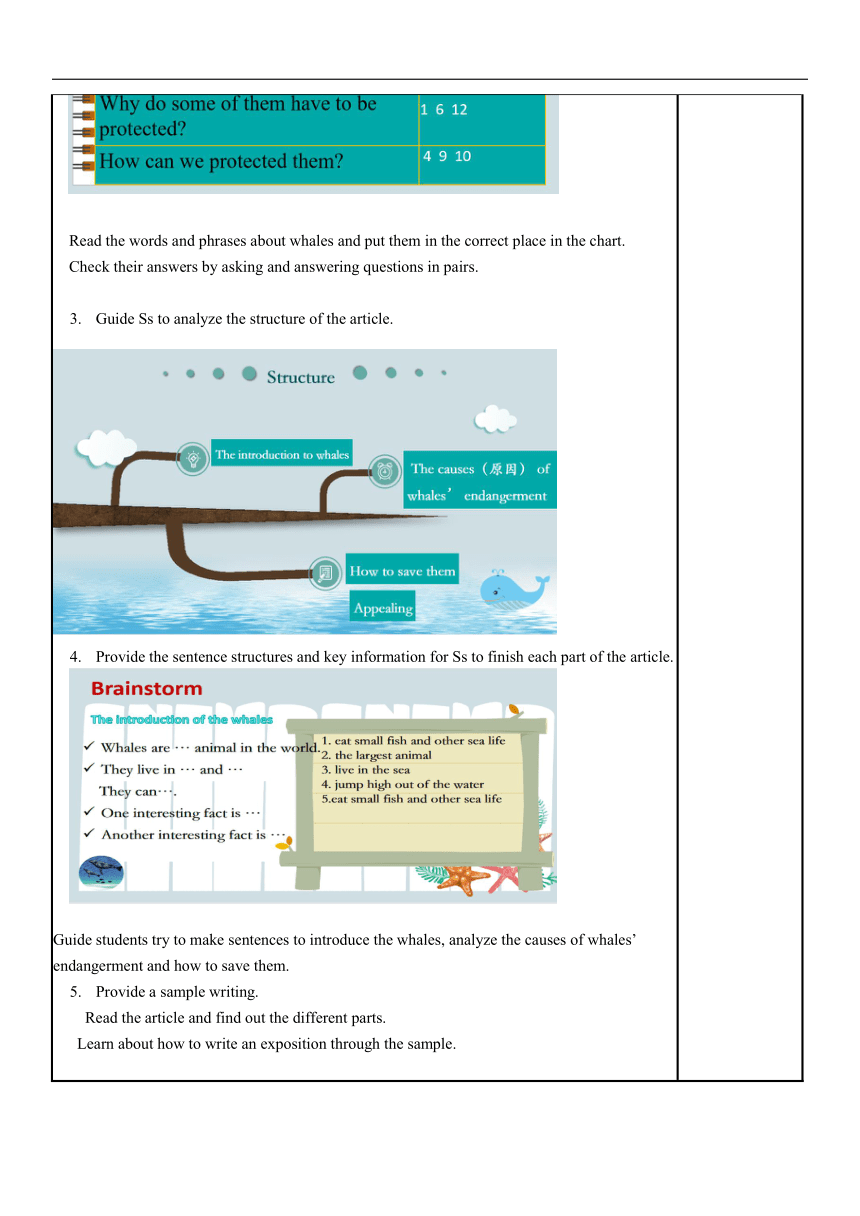Unit 7 What's the highest mountain in the world? SectionB(3a-self check)教案 (表格式)
文档属性
| 名称 | Unit 7 What's the highest mountain in the world? SectionB(3a-self check)教案 (表格式) |  | |
| 格式 | docx | ||
| 文件大小 | 901.8KB | ||
| 资源类型 | 教案 | ||
| 版本资源 | 人教新目标(Go for it)版 | ||
| 科目 | 英语 | ||
| 更新时间 | 2024-03-08 15:04:40 | ||
图片预览



文档简介
人教版英语八年级下册教学设计
年 级 八年级 科 目 英语 授课人 时间
课题名称 Unit7 What’s the highest mountain in the world 课时 Sec B-(3a-self check)
学情分析
教学目标 Language Competence Master new words and expressions: whale, oil, protection, huge. Important sentence patterns: Whales are … They live in … They eat … They can … One interesting fact is … Another interesting fact is … Some kinds of whales are in danger because … We should protect whales from … I think people should / shouldn’t … 2. Students can correctly use the information given and practice writing according to the expository framework presented by 3 B to describe the living habits and living status of whales and express their own opinions.
Cultural Consciousness To express their personal views and discuss how to protect endangered animals in the world, and cultivate students’ comprehensive thinking.. To promote the love of the motherland, reverence for nature and enhance natural confidence and culture.
Thinking Quality Under the teacher’s guide, encourage students to accurately obtain and express the most quality of thinking about the world’s physical geography and the most information about Chinese culture and improve the logic, critical and creative thinking.
Learning Ability Most students will be able to stimulate interest in learning English by talking about the protection of the endangered animals and train the students’ cooperation with their partners.
重点 Use the comparatives and superlatives of adjectives and adverbs correctly. Explain the progress of whale habits and characteristics.
难点 Use and talk about comparative and superlative adjectives correctly. Use the information given and practice writing according to the expository framework.
教学过程 集体研讨
Step 1. Review and lead-in. Show the mind map of the passage in 2b and ask Ss to finish it and retell the information about pandas. T: What other endangered wildlife do you know besides pandas Let students complete the mind map about pandas and retell the passage they’ve learned last class. Talk about the animals they know. Step 2. Pre-writing. Play a video of whales and ask two questions: T: What is this animal T: Can you draw it Show me. Present the words and phrases about whales and let Ss classify them into different kinds. Read the words and phrases about whales and put them in the correct place in the chart. Check their answers by asking and answering questions in pairs. Guide Ss to analyze the structure of the article. Provide the sentence structures and key information for Ss to finish each part of the article. Guide students try to make sentences to introduce the whales, analyze the causes of whales’ endangerment and how to save them. Provide a sample writing. Read the article and find out the different parts. Learn about how to write an exposition through the sample. Step 3. While-writing. Present another instruction of writing. Guide Ss to read it carefully. With the teacher’s help, students analyze the tense, person and text type of the passage they will write. G 2. Guide Ss to draw an outline first. After students drawing the outline, write a passage about pandas based on it. 10 minutes will be given. Step 4. Post-writing. After finishing writing, have a self-check for 3 minutes. Then share their passage with partners and evaluate each other according to the evaluation sheet. Then finish the self check part. Step 5. Conclusion. T: Love animals, love ourselves. Let’s get started now! Step 6. Homework. International Day for Biological Diversity(国际生物多样性日) is on May 22nd. As it is coming, our school will hold a biology festival. Suppose you will give a speech about one of the endangered animals. Please write a speech and introduce a wildlife to us.
Unit 7 B(3a---self check)
教学反思
年 级 八年级 科 目 英语 授课人 时间
课题名称 Unit7 What’s the highest mountain in the world 课时 Sec B-(3a-self check)
学情分析
教学目标 Language Competence Master new words and expressions: whale, oil, protection, huge. Important sentence patterns: Whales are … They live in … They eat … They can … One interesting fact is … Another interesting fact is … Some kinds of whales are in danger because … We should protect whales from … I think people should / shouldn’t … 2. Students can correctly use the information given and practice writing according to the expository framework presented by 3 B to describe the living habits and living status of whales and express their own opinions.
Cultural Consciousness To express their personal views and discuss how to protect endangered animals in the world, and cultivate students’ comprehensive thinking.. To promote the love of the motherland, reverence for nature and enhance natural confidence and culture.
Thinking Quality Under the teacher’s guide, encourage students to accurately obtain and express the most quality of thinking about the world’s physical geography and the most information about Chinese culture and improve the logic, critical and creative thinking.
Learning Ability Most students will be able to stimulate interest in learning English by talking about the protection of the endangered animals and train the students’ cooperation with their partners.
重点 Use the comparatives and superlatives of adjectives and adverbs correctly. Explain the progress of whale habits and characteristics.
难点 Use and talk about comparative and superlative adjectives correctly. Use the information given and practice writing according to the expository framework.
教学过程 集体研讨
Step 1. Review and lead-in. Show the mind map of the passage in 2b and ask Ss to finish it and retell the information about pandas. T: What other endangered wildlife do you know besides pandas Let students complete the mind map about pandas and retell the passage they’ve learned last class. Talk about the animals they know. Step 2. Pre-writing. Play a video of whales and ask two questions: T: What is this animal T: Can you draw it Show me. Present the words and phrases about whales and let Ss classify them into different kinds. Read the words and phrases about whales and put them in the correct place in the chart. Check their answers by asking and answering questions in pairs. Guide Ss to analyze the structure of the article. Provide the sentence structures and key information for Ss to finish each part of the article. Guide students try to make sentences to introduce the whales, analyze the causes of whales’ endangerment and how to save them. Provide a sample writing. Read the article and find out the different parts. Learn about how to write an exposition through the sample. Step 3. While-writing. Present another instruction of writing. Guide Ss to read it carefully. With the teacher’s help, students analyze the tense, person and text type of the passage they will write. G 2. Guide Ss to draw an outline first. After students drawing the outline, write a passage about pandas based on it. 10 minutes will be given. Step 4. Post-writing. After finishing writing, have a self-check for 3 minutes. Then share their passage with partners and evaluate each other according to the evaluation sheet. Then finish the self check part. Step 5. Conclusion. T: Love animals, love ourselves. Let’s get started now! Step 6. Homework. International Day for Biological Diversity(国际生物多样性日) is on May 22nd. As it is coming, our school will hold a biology festival. Suppose you will give a speech about one of the endangered animals. Please write a speech and introduce a wildlife to us.
Unit 7 B(3a---self check)
教学反思
同课章节目录
- Unit 1 What's the matter?
- Section A
- Section B
- Unit 2 I'll help to clean up the city parks.
- Section A
- Section B
- Unit 3 Could you please clean your room?
- Section A
- Section B
- Unit 4 Why don't you talk to your parents?
- Section A
- Section B
- Unit 5 What were you doing when the rainstorm came
- Section A
- Section B
- Review of Units 1-5
- Unit 6 An old man tried to move the mountains.
- Section A
- Section B
- Unit 7 What's the highest mountain in the world?
- Section A
- Section B
- Unit 8 Have you read Treasure Island yet?
- Section A
- Section B
- Unit 9 Have you ever been to a museum?
- Section A
- Section B
- Unit 10 I've had this bike for three years.
- Section A
- Section B
